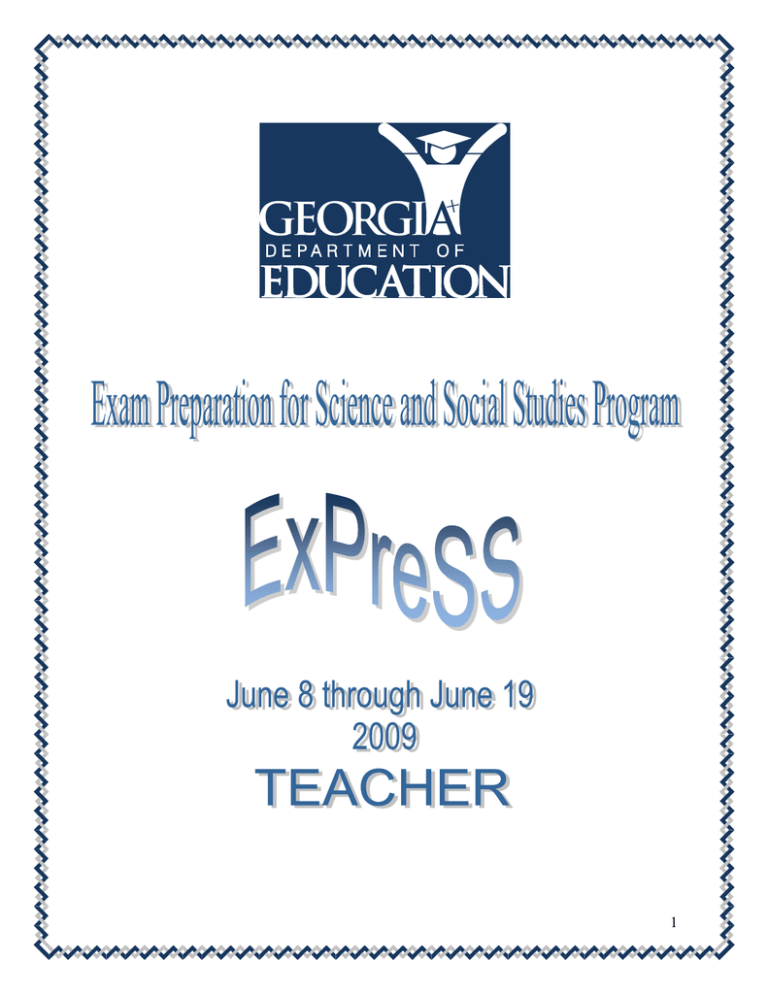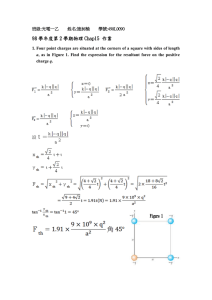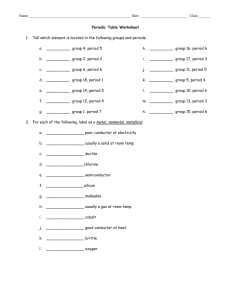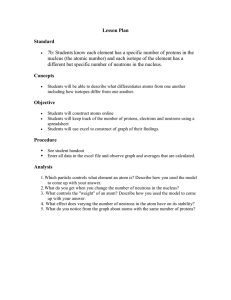General Information and Progress
advertisement

1 Georgia High School Graduation Test Science Content Cells and Heredity Evaluates the nature of the relationships between structures and function in living cells by explaining the roles of cell organelles and by analyzing the function of the four major macromolecules. Evaluates how biological traits are passed on to successive generations by comparing and contrasting the roles of DNA and RNA. Analyze the role of DNA in storing and transmitting cellular information. Explains Mendel’s laws and the role of meiosis in reproductive variability. Investigates the use of DNA technology in forensics, medicine, and agriculture. Derives the relationship between single-celled and multi-celled organisms by analyzing the complexity and organization of organisms in their ability for obtaining, transforming, transporting, releasing, and eliminating the matter and energy used to sustain the organisms. Ecology Describes the interdependence of all organisms on one another and evaluates the relationships among organisms, populations, communities, ecosystems, and biomes. Analyzes the flow of matter and energy through ecosystems as components of a food chain or food web. Structure and Properties of Matter Analyzes the structure of the atom in terms of proton, electron, and neutron locations as well as atomic mass, atomic number, atoms with different numbers of neutrons and different numbers of protons. Explains properties of solutions. Energy Transformations Distinguishes the characteristics and components of radioactivity and explains the process of half-life as related to radioactive decay. Analyzes the atomic/molecular motion of solids, liquids, gases and plasmas. Identifies and explains energy transformation within a system. Investigates and describes molecular motion as it relates to thermal energy changes in conduction, convection, and radiation. Forces, Waves, and Electricity Analyzes relationships between force, mass, and motion by applying the calculations of velocity and acceleration. Evaluates the application of Newton’s three laws in everyday situations related to inertia explaining falling objects as related to gravitational force. Applies mass and weight to appropriate situations. Applies the calculations of work and mechanical advantage to complex systems. Analyzes the properties of waves by explaining the transfer of light, heat, and sound energy through the application of wave theory. Explains the properties of electricity and magnetism by applying and relating these to electromagnets and simple motors. 2 Instructional Calendar at a Glance Day Monday June 8 Tuesday June 9 Wednesday June 10 Thursday June11 Friday June 12 Content Domain: Cells and Heredity Students describe the structures of cells and the structure and function of their components. Students examine the similarities and differences between prokaryotic and eukaryotic cells. Domain: Structure and Properties of Matter Students describe atoms, understanding the structure of an atom. Students identify the symbol, atomic number, and atomic mass of the first 20 elements on the periodic table. Domain: Cells and Heredity Students explain the process of inheritance of genetic traits. Students differentiate between DNA and RNA, recognizing the role of each in heredity. Domain: Structure and Properties of Matter Students apply the properties of solutions, analyzing solutions in terms of solutes and solvents. Domain: Cells and Heredity Students analyze the similarities and differences between organisms of different kingdoms. Domain: Energy Transformations Students understand radioactivity. Students examine the phases of matter and the related atomic and molecular motion. Domain: Cells and Heredity Students explain the process of inheritance of genetic traits. Students demonstrate understanding of Mendel’s Laws in genetic inheritance and variability. Students discuss the use of DNA technology in the fields of medicine and agriculture. Domain: Energy Transformations Students investigate and describe molecular motion as it relates to thermal energy changes in conduction, convection, and radiation. Students analyze energy transformations and the flow of energy in systems. Domain: Cells and Heredity Students differentiate how organisms from different kingdoms obtain, transform, and transport, energy and/or material. Students understand the relationships between single-celled and multicelled organisms, on a broad, conceptual level. Progress Assessment 3 Day Monday June 15 Tuesday June 16 Wednesday June 17 Thursday June 18 Friday June 19 Content Domain: Ecology Students evaluate relationships between organisms, populations, communities, ecosystems, and biomes. Domain: Forces, Waves, and Electricity Analyzes relationships between force, mass, and motion by applying the calculations of velocity and acceleration. Domain: Ecology Students describe the flow of matter and energy through an ecosystem by organizing the components of food chains and webs. Domain: Forces, Waves, and Electricity Students evaluate the application of Newton’s three laws in everyday situations related to inertia explaining falling objects as related to gravitational force. Applies the calculations of work and mechanical advantage to complex systems. Domain: Cells and Heredity Students differentiate the functions of the macromolecules. Students describe the structures of cells and the structure and function of their components. Domain: Forces, Waves, and Electricity Students describe the properties of waves. Domain: Ecology Students use diagrams to interpret the interactions of organisms within food chains and webs. Students determining the role of different organisms in food chains and webs. Domain: Forces, Waves, and Electricity Students understand the properties of electricity and magnetism. Biology Key Concepts – Review Physical Science Key Concepts –Review Administration of the Georgia High School Graduation Test 4 Practice Test 1. Which occurrence is a major source of the gases that can produce acid rain? A. B. C. D. a hole in the ozone layer burning of fossil fuels cloud-seeding by airplanes emissions by nuclear reactors 2. Cells use passive and active transport to move materials across cell membranes in order to maintain a constant internal environment. What is the process of maintaining a constant internal environment called? A. B. C. D. diffusion evolution homeostasis respiration 5. Unlike prokaryotic cells, eukaryotic cells have the capacity to A. B. C. D. assemble into multicellular organisms establish symbiotic relationships with other organisms obtain energy from the Sun store genetic information in the form of DNA 6. An undisturbed deer population grows until its carrying capacity is reached. Which of the graphs below BEST resembles this deer population? 3. Which of the following examples illustrates osmosis? A. B. C. D. Water leaves the tubules of the kidney in response to the hypertonic fluid surrounding the tubules. Digestive enzymes are excreted into the small intestine. White blood cells consume pathogens and cell debris at the site of an infection. Calcium is pumped inside a muscle cell after the muscle completes its contraction. 4. The observed trait that appears in an organism as a result of its genetic makeup is called the organism’s 7. Which of the following practices is MOST likely to slow the buildup of CO2 in the atmosphere? A. B. A. B. C. D. allele genotype phenotype Karyotype C. D. increased use of tropical rain forest areas for agriculture increased use of genetically engineered plants decreased pesticide use in favor of biological controls decreased use of fossil fuels 5 8. Humans have had a tremendous impact on the environment. What has caused an increase in the amount of acid rain? A. B. C. D. 13. The algal cell picture below is a single-celled organism. use of chlorofluorocarbons use of pesticides coal burning power plants nuclear power plants 9. Which of the following is a primary function of carbohydrates? A. B. C. D. storage of energy transmission of genetic material acceleration of chemical reactions transport of molecules across membranes 10. Genetic information usually flows in one specific direction. Which of the following best represents this flow? A. B. C. D. DNA Protein RNA Protein RNA DNA RNA Protein DNA DNA RNA Protein 11. Which of the following is an example of codominance in genetic traits? A. B. C. D. A. B. C. D. The ribosomes are found in the top of the cell. The nucleus is found in the bottom of the cell. The top of the cell contains most of its chromosomes. The bottom of the cell contains most of its cytoplasm. 14. The diagram below shows some of the feeding relationships in a desert food web. A tall pea plant and a short pea plant produce tall pea plants. An orange cat and a black cat produce an orange-and-black kitten. A blue-eyed man and a brown-eyed woman produce a blue-eyed child. A color-blind woman and a man with normal vision produce a color-blind son. 12. A cell has a defect that results in the loss of its ability to regulate the passage of water, food, and wastes into and out of the cell. In which of the following cell structures is this defect most likely to be located? A. B. C. D. When the algal cell is cut in two as shown, the bottom part can grow into a complete cell, but the top part cannot. What conclusion does this support? ribosomes chloroplasts cell membrane endoplasmic reticulum Which of the following trophic levels is not shown in this diagram? A. B. C. D. producers decomposers primary consumers secondary consumers 6 15. A mutation that prevents a maple tree from efficiently taking gases from the air would most directly affect which of the following processes A. B. C. D. reproduction photosynthesis water uptake DNA replication 16. As you move from left to right across a row of elements in the periodic table, what happens to the number of neutrons in a typical atom? A. B. C. D. It stays the same. It increases. It decreases. It decreases until you reach the middle and then it increases. 17. Which of the following could be used to convert light energy to electrical energy? A. B. C. D. a windmill a chemical storage battery a solar cell rotating coils in a magnetic field 18. In a restaurant kitchen, lamps are used to keep food warm. Which type of electromagnetic radiation do the lamps emit that is primarily responsible for keeping the food warm? A. B. C. D. gamma infrared ultraviolet visible 19. Carbon atoms can link themselves together into long chains and rigs to form a vast number of highly complicated molecules. Which of the following statements BEST explains why carbon atoms behave this way? A. B. C. D. They easily form ionic bonds with each other. They easily form covalent bonds with each other. They easily combine with atoms of oxygen. They easily become highly charged ions. 20. Which of the following situations violates the law of conservation of energy? A. B. C. D. A ball dropped from the top of a building increase in speed until it hits the ground. A block sliding freely on level ice increases in speed until it hits a wall. A child playing on a swing moves fastest at the bottom of the swing’s path. The height a ball bounces decreases with each bounce. 21. Aluminum oxide, Al2O3, is produced by combining Al3+ and O2- particles. What type of compound has been formed? A. B. C. D. covalent ionic metallic molecular 22. Which of the following pairs are isotopes of the same element? A. B. C. D. atom J (27 protons, 32 neutrons) and atom L (27 protons, 33 neutrons) atom Q (56 protons, 81neutrons) and atom R (57 protons, 81 neutrons) atom V (8 protons, 8 neutrons) and atom W (7 protons, 8 neutrons) atom S (17 protons, 18 neutrons) and atom T (18 protons, 17 neutrons) 7 23. An ionic bond typically forms between certain types of elements. Which pair of elements will form an ionic compound? A. B. C. D. 27. In the absence of air resistance, which of these objects will fall at the fastest rate when dropped? Na and Cu K and Cl Ne and O Li and Mg 24. Albert stirs a mug of hot chocolate with a metal spoon. What type of heat transfer is responsible for the spoon getting hot? A. B. C. D. conduction convection thermoelectric radiation 25. A student connects three identical light bulbs in a parallel to a dry cell as shown below. What happens when the student removes one of the light bulbs from its socket? A. B. C. D. the ball with a mass of 75 kg the ball with a mass of 25 kg the ball with a mass of 10 kg They all fall at the same rate. 28. Which pair of elements is MOST similar? A. B. C. D. Ca and F Na and Cl Ne and Ar Li and H 29. A box of weight W is lifted by a force F using a lever as shown below. A. B. C. D. All the light bulbs go out. The other light bulbs remain on and will be equally bright. The other light bulbs remain on, one less bright and the other the same brightness as before. The other light bulbs remain on, one brighter and the other less bright than before. 26. Which of the following are transferred of shared when two atoms react chemically? A. B. C. D. What is the mechanical advantage of the lever? A. B. C. D. 1 2 2 3 6 protons neutrons electrons photons 8 30. An airplane in level flight is acted on by four basic forces. Drag is air resistance, lift is the upward force provided by the wings, thrust is the force provided by the airplane’s engines, and weight is the downward force of gravity acting on the airplane. 32. A sound wave is produced and begins to travel from left to right through four different media. The speed of the wave varies as it travels. The media are solid, liquid, gas, and vacuum, but not necessarily in that order. Which speed MOST likely represents a gas? In level flight at constant speed, which pair of forces must be equal A. B. C. D. lift and drag drag and weight lift and weight thrust and lift 31. Pat measures a small rubber ball and then makes three other balls of the same diameter from lead, foam, and wood. Which ball has the greatest inertia? A. B. C. D. the rubber ball the lead ball the foam ball the wood ball A. B. C. D. 1 2 3 4 33. A car was sitting in sunlight all day long. The heat that is now contained in the car was transferred to the car primarily by which of the following processes? A. B. C. D. convection conduction radiation electrical energy transfer 34. Four identical light bulbs are connected in a circuit as shown below. The current is greatest through which of the light bulbs? A. B. C. D. 1 2 3 4 9 35. What property of electromagnetic waves makes it possible to use these waves to transmit information between a space shuttle and NASA mission control centers on the ground? A. B. C. D. Electromagnetic waves are transverse waves. Electromagnetic waves have very low velocity. Electromagnetic waves are all visible to human eyes. Electromagnetic waves can travel through a vacuum. 36. Which of the following is certain to change as a ball accelerates? A. B. C. D. mass of the ball inertia of the ball velocity of the ball force acting on the ball 37. The diagram below shows two aluminum spheres 38. The chart below shows a portion of the electromagnetic spectrum. A plastic filter is fitted over a light. The light emits white light, but the filter only lets the longest wavelengths of visible light pass through. Which color would a person looking at the filtered light see? A. B. C. D. 39 A party shop delivers helium-filled balloons to homes and businesses. The owners realize from experience that on hot summer days they should inflate the balloons only three-quarters full. On cold winter days they can fully inflate the balloons. Which of the following is the best hypothesis to explain this observation? A. B. C. D. Aluminum sphere A contains a small negative charge and is touched by aluminum sphere B, which has a larger negative charge. Which of the following occurs next? A. B. C. D. green red violet yellow The helium gas is more active in the winter season. Air outside the balloons leaks into the balloons. As the temperature increases, the helium in the balloons expands. Outdoor air pressure in the summer is less than indoor air pressure. Protons flow from sphere B to sphere A. Protons flow from sphere A to sphere B. Electrons flow from sphere B to sphere A. Electrons flow from sphere A to sphere B. 10 40. The diagram below shows a sea star in various stages of regeneration. 42. DNA and RNA are similar because the both contain A. B. C. D. What cellular process is directly responsible for this regeneration? A. B. C. D. deoxyribose nucleotides thymine double helices 43. The diagram below shows a food web. meiosis mitosis transpiration respiration 41. The diagram below shows an energy pyramid. Which population would probably increase if the tadpole population decreased? A. B. C. D. herons alligators fish algae 44. Many animals have internal or external skeletons that provide support and structure. Which of the following parts of plant cells play a similar role? Approximately how much energy is available to the secondary consumers in this energy pyramid? A. B. C. D. A. B. C. D. cell membranes cell walls chloroplasts cytoplasm 10 kcal/m2/year 100 kcal/m2/year 1,000 kcal/m2/year 5,000 kcal/m2/year 11 45. The picture below shows two dogs and their puppies. 46. A student heated a 10 g sample of a compound in an open container. A chemical reaction occurred. The mass of the sample was measured again and found to be less than before. Which of the following explains the change in mass of the sample? A. B. C. D. The parent dogs are each heterozygous for two traits: fur color and white spotting. Both parent dogs are solid black. Their puppies, however, have four different phenotypes as listed below. solid black black with white spots solid red red with white spots Which of the following explains how these parent dogs can produce puppies with these four phenotypes? A. B. C. D. The genes for these traits are sex-linked. The genes for these traits mutate frequently. The genes for these traits assort independently. The genes for these traits are on the same chromosome. The heat caused the compound to become less dense. The reaction gave off more heat than was added. Some of the lighter atoms were converted to energy. One of the reaction products was a gas. 47. Which of the following represents a pair of isotopes? A. 1 H and 3H B. 16 O2- and 19F1- C. 40 K and 40Ca D. 16 O2- and 32S2- 48. The water from hot springs near the Ebeko volcano in the Pacific Ocean has a very low pH. A low pH indicates which of the following about the water? A. B. C. D. It has no detectable H+ or OH- ions. It has equal concentrations of H+ and OH- ions. It has high concentrations of H+ ions. It has equal numbers of positive and negative ions. 12 49. The illustration below shows four containers. Each container is full of helium gas at a different temperature. 50. While hiking through Granville State Forest, a student finds an unusual plant-like organism that appears to lack chlorophyll. When the student examines a sample using a microscope, he sees many cells with cell walls and no chloroplasts. This organism is most likely a member of what Kingdom? a. b. c. d. Animalia Eubacteria Fungi Protista If all of the containers are closed and have a pressure of 1 atm, which container has helium particles with the greatest average kinetic energy? A. B. C. D. 1 2 3 4 13 Practice Test Answer Sheet Name: _______________________________________ Question Question Question 1. A B C D 21. A B C D 41. A B C D 2. A B C D 22. A B C D 42. A B C D 3. A B C D 23. A B C D 43. A B C D 4. A B C D 24. A B C D 44. A B C D 5. A B C D 25. A B C D 45. A B C D 6. A B C D 26. A B C D 46. A B C D 7. A B C D 27. A B C D 47. A B C D 8. A B C D 28. A B C D 48. A B C D 9. A B C D 29. A B C D 49. A B C D 10. A B C D 30. A B C D 50. A B C D 11. A B C D 31. A B C D 51. A B C D A B C D 32. A B C D 52. A B C D 13. A B C D 33. A B C D 53. A B C D 14. A B C D 34. A B C D 54. A B C D A B C D A B C D 55. A B C D 16. A B C D 36. A B C D 56. A B C D 17. A B C D 37. A B C D 57. A B C D 18. A B C D 38. A B C D 58. A B C D 19. A B C D 39. A B C D 59. A B C D A B C D 40. A B C D 60. A B C D 12. 15. 20. 35. 14 General Resources 15 ` 16 SCIENCE FACTS AND FORMULAS Some of the questions in this test require you to solve problems. This page contains all the basic facts and formulas you will need to solve those problems. You may refer to this page as often as you wish while you take the test. Some questions may require information from the periodic table on the previous page. Basic Facts Acceleration due to gravity = 9.8 meters/second/second (9.8 m/s2) Weight = Mass (m) Acceleration due to gravity (g) (W = mg) Density = Mass/Volume Volume of a Rectangular Solid = Length Width Height 1 Newton = 1 kilogram meter/second/second 1 joule = 1 Newton meter 1 watt = 1 Newton meter/second = 1 joule/second Motion Velocity (V) = V0 + at, Where V0 = Initial Velocity, a = Acceleration, and t = Time Acceleration = Change in Velocity/Time Elapsed a V V0 t Force Force = Mass Acceleration (F = ma) Mechanical Advantage Actual Mechanical Advantage: AMA FR FE Where FR is Force due to resistance and FE is Force due to effort. Ideal Mechanical Advantage: IMA Effort Length Resistance Length Work Work = Force Distance Electricity Voltage = Current Resistance 17



